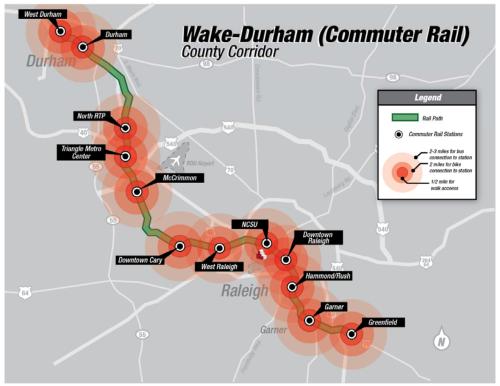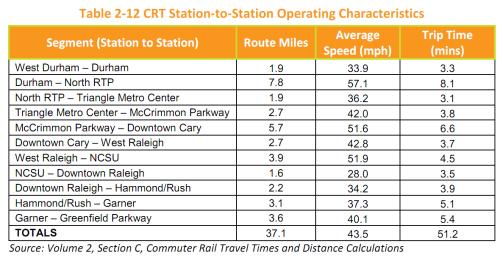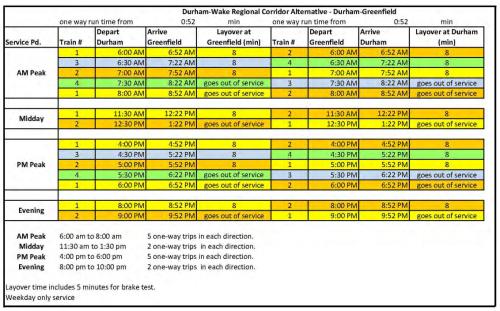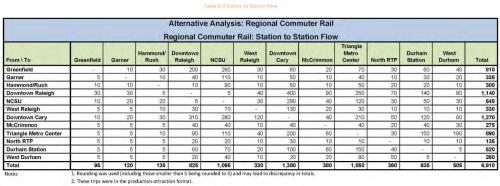Tomorrow is an interesting day for transit fans as Durham County steps up to tax themselves in order to bring upgrades to our region’s transit. A one-half cent sales tax increase will be on the ballot in order to make these things happen. Readers should pay close attention because Raleigh’s close buddy may be bringing some goods to this symbiotic metropolitan partnership.
The informative website Our Transit Future (OTF) has documents aplenty to read up on but in case you haven’t gone through them, I’d like to attempt to summarize some of the things that may benefit Downtown Raleigh in the near future if Durham voters approve the tax increase. The documents there describe future stations, timetables, expected ridership, and other facts that could come into reality in the Triangle within the next decade.
Clearly, this blog supports the upgrade of transit in the Triangle and I hope that this tax is passed in Durham County. Let’s see what aspects of the plan may have an impact on downtown.
Durham’s Plan Links To Raleigh
The Durham County transit plan will go towards the following Raleigh related improvements, according to the fact sheets listed on the OTF site:
Step 2 – Rail from Durham to RTP and Raleigh
- 2012 – Initial planning and engineering begins
- 2018 – Opening year of peak hour rail connection to RTP and Raleigh
– Length of corridor: 37 mi.
– End to end travel time: 51 min.
– 4 stations in Durham county
- Later Saturday and Sunday connectivity between Downtown Durham and Downtown Chapel Hill; between Downtown Durham, RTP, and Raleigh; and, between Chapel Hill, southern Durham, RTP, and Raleigh.
- More frequent express trips between Durham and Raleigh.
Here’s a map of the commuter rail line planned for the Triangle going from West Durham to Greenfield Parkway, Garner.
There are some explanations as to why commuter rail is being planned from Raleigh to Durham while light rail is being planned from Durham to Chapel Hill.
Why is light rail the technology for the Durham to Chapel Hill rail line and commuter rail the technology for the Durham to RTP and Raleigh rail line?
The different technology choices for the Durham to Chapel Hill and Durham to RTP and Raleigh rail systems were chosen to best respond to the characteristics of the travel markets in each corridor.
Durham to Chapel Hill Light Rail: This 17-mile corridor already has high traffic, a demand for transit and features three travel markets that include all-day trips and many short trips:
- Work and student trips to Duke University/Hospital and Downtown Durham from the west
- Work and student trips to UNC-Chapel Hill/Hospital from the east
- Low-income work and shopping trips from East Durham to retail districts along 15-501
Additionally, the corridor features significant special event attractions such as DPAC, Brightleaf Square, Ninth Street, and UNC Dean Dome. Some of the most-densely populated census tracts in the Triangle including UNC’s main campus and Duke’s east campus are within a short walk to rail stations. This rail corridor is also well-positioned to capture the already-existing 3,000 to 4,000 daily bus transit riders from points east traveling to UNC via park and ride and Triangle Transit services such as bus 805 in Woodcroft in South Durham.
Durham to RTP and Raleigh: This 37-mile corridor features multiple travel markets with long trip lengths:
- Work and student trips to NCSU/Downtown Raleigh
- Work trips to Duke Medical Center
- Work trips to Research Triangle Park
The corridor features considerable work trips but comparatively less non-work trips than the Durham-Chapel Hill corridor. There is existing heavy transit demand for NCSU, and considerable transit demand for employment trips to downtown Raleigh. These long transit trips remove large amounts of vehicle miles traveled from regional highways, and
the higher average speed of commuter rail over great distances makes it the ideal technology to attract motorists out of their cars with speeds that will most likely be unachievable by car during rush hour in the future.
The documents also predict a daily ridership of 7,000 boardings per day between Raleigh and Durham.
Corridor Studies, The Gritty Details
Outside of the documents that revolve around the tax increase and transit investment plan are others that focus on the three transit corridors with much more details. (up to date as of July 2011) Those three are:
- Durham-Orange Corridor
- Durham-Wake Corridor
- Wake Corridor
While the Wake Corridor information impacts downtown Raleigh more, tomorrow’s vote in Durham will most likely help some of the plans documented at the Durham-Wake Corridor link more. Having said that, I’ll focus only on the documents at that link and save the Wake Corridor for another time. (maybe when Wake votes for transit improvements next year?)
Commuter Rail
- The commuter rail line between Durham and Garner will run in the North Carolina Railroad Corridor.
- NCDOT will double track certain section in order to separate other rail traffic. (freight and high-speed)
- Proposed Downtown Raleigh station location:
– Location in existing railroad right-of-way neat the intersection of West and Davie Streets.
– Station would have walk-up features, at-grade, side platform and pedestrian access to future Union Station.
This table shows the Commuter Rail Station-to-Station Operating Characteristics.
This table breaks down the 51 minute end-to-end trip time so with it we can predict how long it will take to get to and from popular locations.
- Downtown Raleigh and Downtown Cary: 11.7 minutes
- Downtown Raleigh and North RTP: 25.2 minutes
- Downtown Raleigh and Downtown Durham: 33.3 minutes
FYI, the North RTP station is approximately located near the intersection of Miami Boulevard and Cornwallis Road.
While weekend service is not planned, weekday service hours of commuter rail could look like what is described in this table.
If you are a map person and would like to view each and every section of the commuter rail line from end-to-end, jump into this 14 MB pdf here. There are also more detailed topography maps available for the entire line at the corridor link.
Below is a proposed platform layout for the downtown Raleigh station followed by an example of how other stations might look. The downtown platform would sit between the two tracks rather than having two side platforms.
Last, I’ve posted what I think is the most interesting table in all of the documents. Here are the projected ridership numbers from station to station. The table is packed so make sure and click the image to view it larger.
According to the table above, the most trafficked stations will be Downtown Cary, Downtown Raleigh, and NCSU, in that order. You can see that most of the traffic comes between Downtown Cary and to either NCSU or Downtown Raleigh. I feel this is predicting a future scenario where commuters park and ride into Raleigh.
To dissect the downtown Raleigh numbers even further, we’ll start with the 825 arrivals and 1,140 departures figures in the table. There are assumptions that about 15% of trips will be ones that do not involve a person’s home. Thinking about these numbers, this has to explain the difference of 315 between arrivals and departures. (do the math) So an educated guess as to a person’s non-home based trip would be something like leaving downtown to go to the airport for example.
So how can we have more people leave then show up each day? This is what I need to explore more as the numbers suggest that in some cases people will be arriving in downtown using some other method but leaving on the commuter rail lines. If anyone has any information on this I would most appreciate an insight to this.
Comments
Comments are disabled here. That's because we're all hanging out on the DTRaleigh Community, an online forum for passionate fans of the Oak City.






Where is the Raleigh North and South link? Again, this MUST be elevated light rail throughout the system, not trains on existing tracks. Invest whatever amount of money it takes to do this right Raleigh. Stop cutting corners on projects that are the foundation of the regions future (have some vision instead of throwing something together that is a quick fix).
This has been in the planning stages for years, all associated with the plans should be fired if this is thrown together and not a light rail system
Thomas, if you look at the Wake Corridor link you’ll see more details on the alternatives for the light rail plan in Wake County.
Let me be clear that the Durham County transit referendum which passed yesterday will fund buses in Durham County in the short term followed by the commuter rail line from Garner to West Durham. Down the road it will also go towards a light rail line from Durham to Chapel Hill.
If you want to see the light rail line from Cary to North Raleigh, going through downtown Raleigh, we need funding for it and the appropriate route is get the Wake County commissioners to put the 1/2 cent sales tax increase for transit on the ballot sometime soon. Whenever they announce that the tax increase will be on the ballot, make sure to go out and vote for it as Durham County has recently done.
I can’t wait for a nice light rail system – well connected with other public transit options – materializes. Unfortunately, the problem remains… Where is the density to support this system? In this economy it is tough to expect developers to come forth with solid plans, but we need at least a good vision to show what our leaders would like to see, besides arguing about the routes and other things. Is it possible to get the needed density in order to get this system going to the right direction?
TTA’s previous vision had all the political support it needed, but failed miserably to make the numbers work. Not to mention the STUPID idea to ask the Feds for 61% funding. What were they thinking? There were other proposals with higher priority, servicing more people than our previous plan, and asking for less… Let’s hope this time we work as a region and put aside any over-ambitious ideas.
I don’t understand. How do we have a light rail from Durham to Raleigh that DOESN’T stop at the airport? If there’s no way to take the rail to RDU, this plan fails.
Totally agree Kevin. Bringing in the airport is essential to any planned rail.
Kevin,
I agree with you. How can this NEW Tranist Group not include a connection to RDU (not a bus link, but a light rail link to both terminals – and the new RDU terminal made a huge mistake by not designing the new terminal to have a light rail station stop right in the terminal – JUST LIKE DETROIT’s NEW TERMINAL – RDU’s lack of vision once again)?
The previous Tranist Group faliled to include a light rail stop at RDU in the plans, now this NEW Group is repeating the same mistake – are you kidding!!! (spend the MONEY and BUILD THIS LIGHT RAIL SYSTEM TO BE THE BEST IN THE COUNTRY – instaed of half _ _ _)
Before y’all get too upset, let me mention that RDU is the one to answer this, not the Transit Group. The former stands to lose a lot if there is a stop, due to reduced income from parking. This was their issue before and remains to be an issue to this day. Unless traffic increases dramatically, to the point that RDU cannot serve its customers, they will not jump on the bandwagon.
Problems existed before with Duke Hospitals (in Durham) and the town of Morrisville, although these issues were related to placing an actual station in their boundaries. Totally stupid, if you ask me, but it was not the TTA group that lacked vision – in those instances – but some of the entities that could benefit the most, in the long run.
Kevin, Mike, Thomas, I partially disagree.
I think people need to take a step back and reevaluate their obsession with this “it must go to the airport” love affair. There’s no doubt that this plan laid out here is phase one in a multi-phase transit plan for the entire triangle. There’s talk about some type of a connection to the airport in the future but nothing concrete is out there that is worth mentioning at this point.
To get some kind of transit system up and running, planners are clearly building a system that offers a balance between cost and having a solid ridership. It makes it easier to ask for funding from the state, federal govt, and/or puts transit tax money to better use.
Commuters going between the home and work is what this plan will be for as that will bring the highest amount of initial riders. According to the documents I link to, 67% of commuters on the commuter rail will be going from their home to work. RDU is not a large enough employment hub to justify sending rail through it. Commuters go to work multiple times a week, how many times do you and I fly per week?
To balance out cost, using the existing NC Railroad corridor keeps the cost relatively low compared to building new track outside of the corridor. To bring rail to the airport would involve lengthy environmental studies and new engineering obstacles that take time and even more money. The cost to go to the airport is very great for such a small gain, add on top of that a huge risk for this new rail system. Do you think lenders will back it with that much risk?
Now I only partially disagree because I feel that the airport link should happen but only AFTER we’ve proven that rail works here in the triangle. Put it in phase two or three of our master transit plan but don’t risk phase one planning for something with a huge risk of having low ridership.
RDU would be nice. It’s not a deal breaker.
Bringing rail through the airport on the way from Raleigh to Durham is a problem because to do so you would wind up bypassing RTP.
That said, here is my idea for an EVENTUAL connection to RDU.
-Let the commuter line go straight between Durham and Raleigh.
-When the light rail line gets extended, extend it east from Durham in the median of US 70, which will eventually be upgraded to a freeway between Durham and 540.
-Pass the line through Brier Creek and RDU (with a single stop between the terminals – that should be enough.) There’s a nice covered walkway with moving sidewalks between the terminals.
-Pass through Perimiter Park and meet up with the Wake light rail line at NW Cary Parkway.
I agree with Leo’s and orulz’ comments regarding the success of the proposed light rail plan. As long as we connect employees with major employment centers (and shopping destinations) we should be fine… for Phase 1, at least.
My concern is that we don’t see new major developments following, even as a concept. It goes without saying that these developments need to be urban in nature, dense and mixed-use. Cherokee Investments was a good start, but they “disappeared” from the map once TTA’s original plan died; they had already ran into some legal troubles, if I recall correctly. Once we create denser urban areas around the stations, it will be easier to expand the line in the future, assuming Phase 1 will be successful.